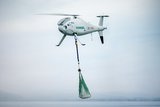HoodTech Vision introduces dual-payload on a single aircraft
HoodTech Vision has demonstrated the ability for a single aircraft to carry two stabilised imaging systems. The system allows operators to simultaneously and independently operate the two payloads for operations on manned or unmanned aircraft.
The company’s on-board aircraft electronics provide power, video, and control function management of the payload. The new dual-payload imaging systems on a single, manned aircraft are controlled by a rear-seat payload operator with analogue video ground-link hardware. Video signals from each payload are multiplexed to the downlink hardware via computer control. Ground-based payload control has been successfully demonstrated on the various aircraft.
Chris Johnston, VP sales and marketing Infrared Projects, HoodTech Vision, said that two of the 4-axis, gyro-stabilised, imaging payload systems have been delivered to international customers for installation on a single aircraft.
He said: ‘The EO payload was an adaptation of HoodTech's field-proven Alticam 09EO1 product that offers National Imagery Interpretability Rating Scale (NIIRS) level 9 for airborne imagery from a 4,200 ft slant range, along with a continuous zoom MWIR payload based upon our Alticam 09MWIR2 product.
‘In a separate activity, HoodTech Vision has also demonstrated two-payload operations from a small UAS where a centre-of-gravity (CG) payload was mounted, in addition to a standard, nose-mounted payload. Both EO-only and EO/IR payloads were installed and operated in the CG position. A standard EO/IR payload occupied the nose position on the UAS. Independent imager control, articulation, and tracking were successfully accomplished. HoodTech and its customer partner realised great value in the 2-payload load-out when interrogating two, independently-operating targets from a single airplane. Situational awareness was increased in both the single target and dual-target scenarios.’
More from Uncrewed Vehicles
-
Jammer resistant drone designs spark search for countermeasures
The Russia-Ukraine conflict has driven another stage of evolution for drones and the counter measures to defend against them.
-
![L3Harris launches Amorphous software for control of uncrewed platforms]()
L3Harris launches Amorphous software for control of uncrewed platforms
The new Amorphous software is a universal controller that would allow a single operator to control a swarm of “thousands” of uncrewed systems, from drones to underwater platforms.
-
ideaForge unveils new UAVs at Aero India 2025
India UAV supplier ideaForge has launched the Netra 5 and Switch V2 drones at Aero India 2025, boasting of enhanced endurance, AI-driven autonomy and improved operational capabilities.
-
![Shaping the future of defence: What 2025 holds for the global drone market]()
Shaping the future of defence: What 2025 holds for the global drone market
The UAV market is experiencing unprecedented growth, with innovations in technology and battlefield applications driving demand across military sectors. From the battlefields of Ukraine to NATO exercises and beyond, drones are transforming how wars are fought and supported.
-
![Maris-Tech confirms customers signing up for Jupiter Drones codec and AI-powered system]()
Maris-Tech confirms customers signing up for Jupiter Drones codec and AI-powered system
Launched at AUSA in October, the company’s multi-stream video codec is attempting to bring a new lease of life to drone technology through its AI accelerator.
-
![AUSA 2024: Quantum-Systems targets big 2025 with UAS developments]()
AUSA 2024: Quantum-Systems targets big 2025 with UAS developments
Quantum-Systems has been upgrading its UAS family, with new versions of the Vector, Reliant and Twister drones set for release throughout 2025.
























